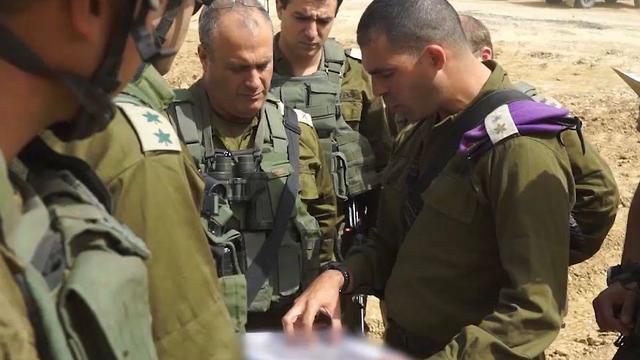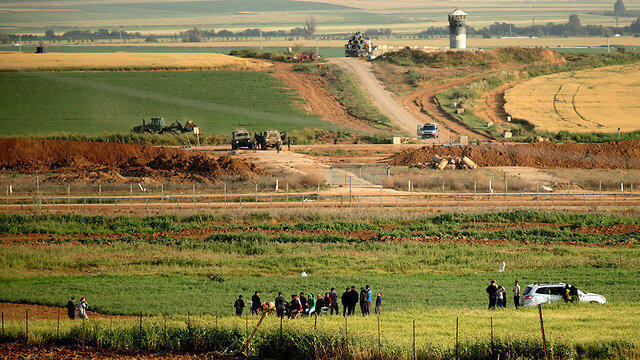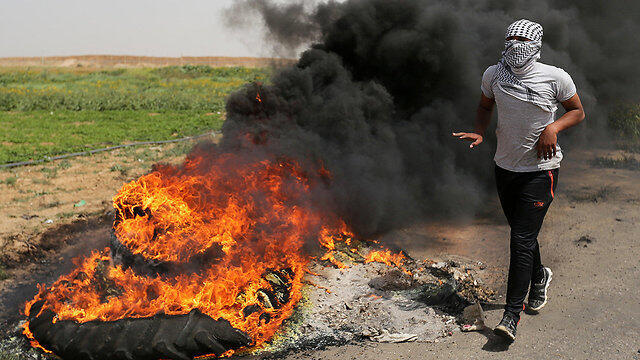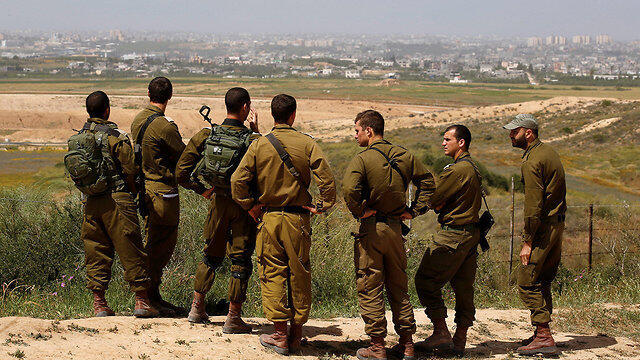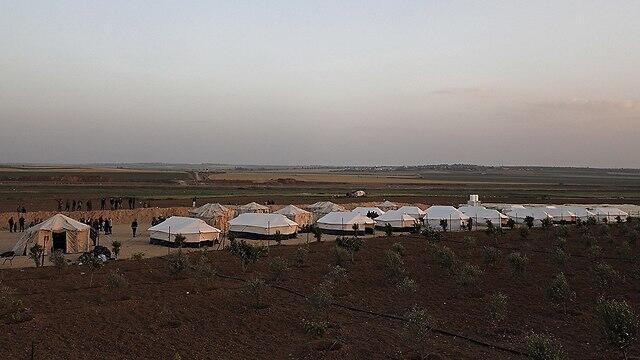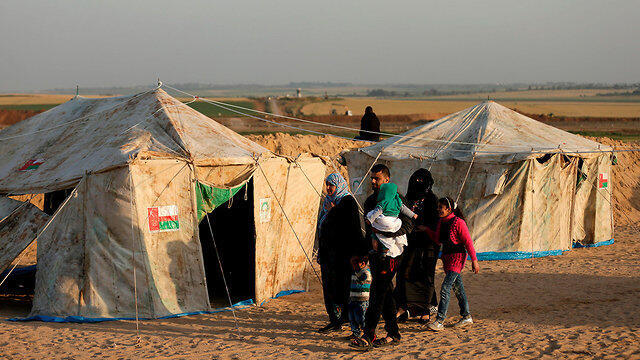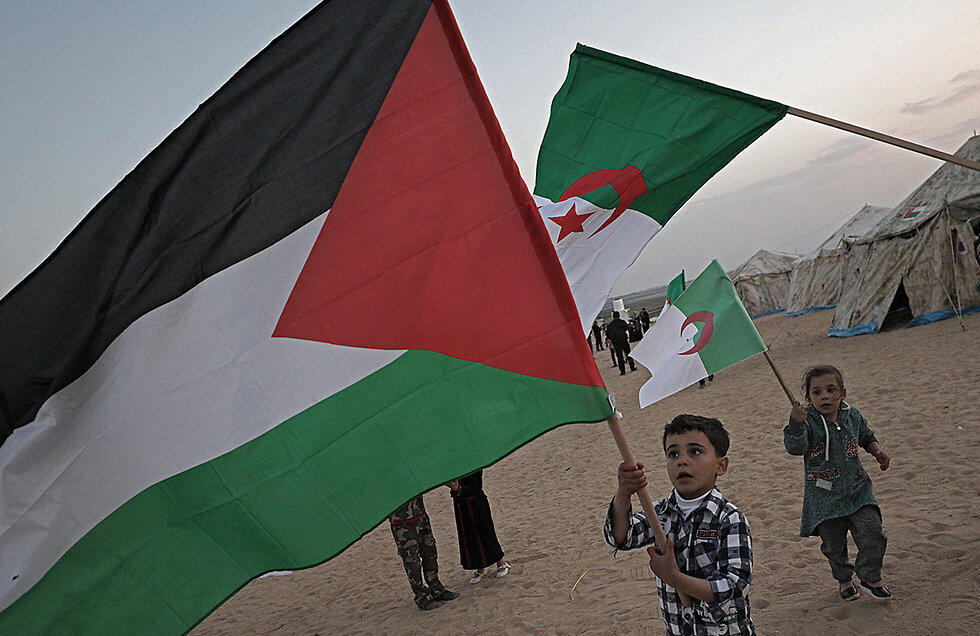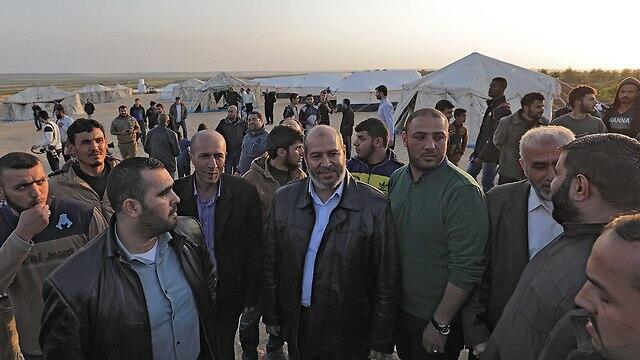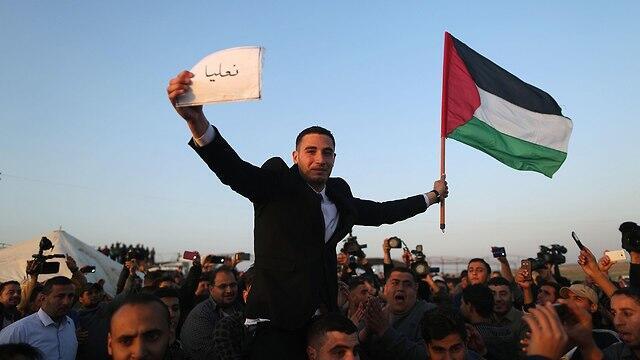Getting your Trinity Audio player ready...
The IDF was making final preparations Thursday night ahead of the Palestinian "Great March of Return" towards the Israel-Gaza border fence on Friday.
Thousands of soldiers from the Golani Brigade, the Armored Corps, the Nahal Brigade and the Givati Brigade, as well as troops from the Combat Intelligence Collection Corps, Air Force video units and Special Forces will be deployed along the Gaza frontier, while parts of the border area will be declared closed military zones.
The Seder night breaks for hundreds of soldiers currently in training had to be canceled so reinforcements could be sent to the Gaza border.
Palestinians prepare for 'March of Return'
(צילום: רויטרס)
The IDF has completed works to build fortifications in the form of massive mounds of earth, behind which dozens of snipers will be stationed on Friday.
IDF engineering forces also set up barbed-wire fences to make it harder on Palestinians who may attempt to cross the border fence.
The march is expected to begin in the late morning hours, and it is part of a broader Palestinian campaign that begins Friday, Land Day, and is set to end in a month and a half on May 15—Nakba Day. Buses to the border will leave from all across the Gaza Strip after noon prayers.
While the height of the Palestinian campaign is expected around Israel's Independence Day and the opening of the new US Embassy in Jerusalem, defense officials estimate that thousands of Palestinian protesters will take part in the march on Friday in more than 10 locations along the border—from the Erez Crossing in the north of Gaza to the Kerem Shalom area in the enclave's south.
The IDF wishes to prevent a "photo of victory" from Hamas—either of Palestinian rioters crossing the border fence and planting a Palestinian flag on the Israel site, or of many bodies of rioters shot to death by the IDF.
To that end, troops have been equipped with gas and stun grenades as well as other crowd dispersal measures in an effort to avoid the use of live fire against the protesters as much as possible.
The IDF forces will also be using multirotor drones and tactical drones, which will be flying over friction points to monitor rioters and alert the troops to their actions.
The troops have been preparing to face worst-case scenarios, including an attempt by Hamas fighters to infiltrate Israel under the cover of the protests—either through tunnels or from above ground—and attack the soldiers who would be distracted by the rioting. The soldiers are also prepared for possible sniper fire from Gaza under the cover of the protests.
The IDF urged Israeli citizens living in the border area not to break from their daily routine, and no restrictions have been placed on them or visitors expected to arrive at the western Negev area during the intermediate days of Passover.
Meanwhile, the Palestinians completed their own preparations for the march, with tent encampments erected in five locations along the border to house the protesters who arrived from across the Gaza Strip.
The encampments are some 700 meters from the Israeli border and in the next month and a half different groups are expected to stay there every day.
In addition, emergency services in the Gaza Strip have gone into high alert ahead of the campaign.
Hamas issued an unusual statement on Thursday evening, calling on the masses expected to take part in the "Great March of Return" to stick to "peaceful ways" of protest.
Deputy Hamas leader in Gaza, Khalil al-Hayya, visited the tent encampments on Thursday and delivered a similar message, calling for mass participation but stressing the protest should be done in "peaceful ways."
The IDF has been issuing daily warnings to the residents of Gaza ahead of the planned protest. On Tuesday evening, it warned the residents not to approach the border fence with Israel during their “Great March of Return” planned for Friday, and described it as a “March of Anarchy."
In a video posted in Arabic on the IDF Spokesperson’s Unit Facebook page, residents were told that Hamas was using them as a decoy in its violent schemes rather than providing solutions to the problems that Gazans face.
The Coordinator of Government Activities in the Territories (COGAT), Maj. Gen. Yoav Mordechai, has further warned bus companies in the Gaza Strip not to cooperate with Hamas by driving residents toward the border fence.
“Anyone who approaches the border is endangering his life. From my point of view, if bus companies you own takes some of the protesters and brings them to the border, you and your families will be held personally responsible,” Mordechai warned during an interview on the US-based public Arabic-language satellite TV channel Alhurra.
While Palestinians in Gaza will march towards the border, their brethen in the West Bank will also hold protests to mark Land Day, which commemorates the six Arab citizens of Israel killed by Israeli security forces in demonstrations in 1976 over land confiscations. The main demonstration is set to take place at the Beit El checkpoint, which leads to Ramallah.


